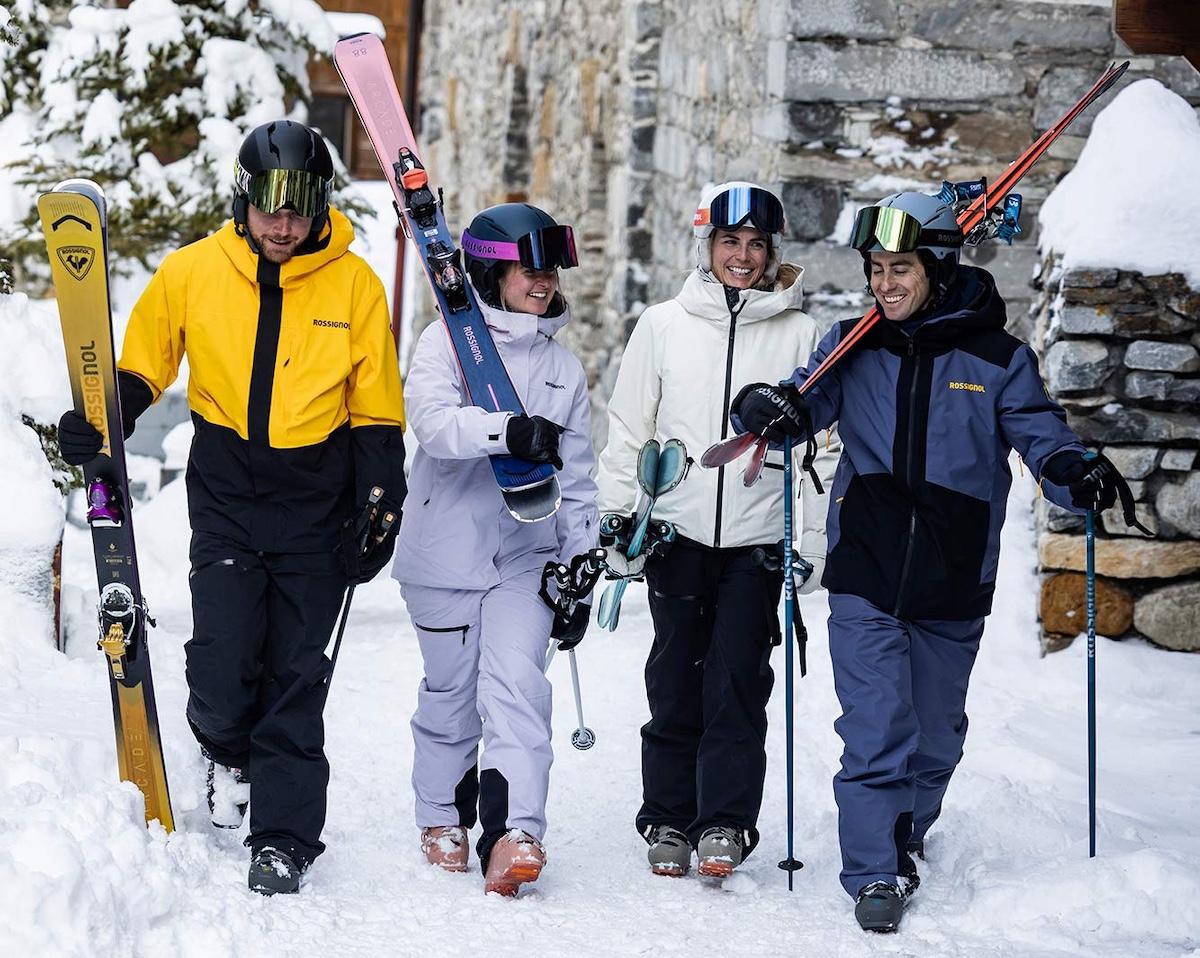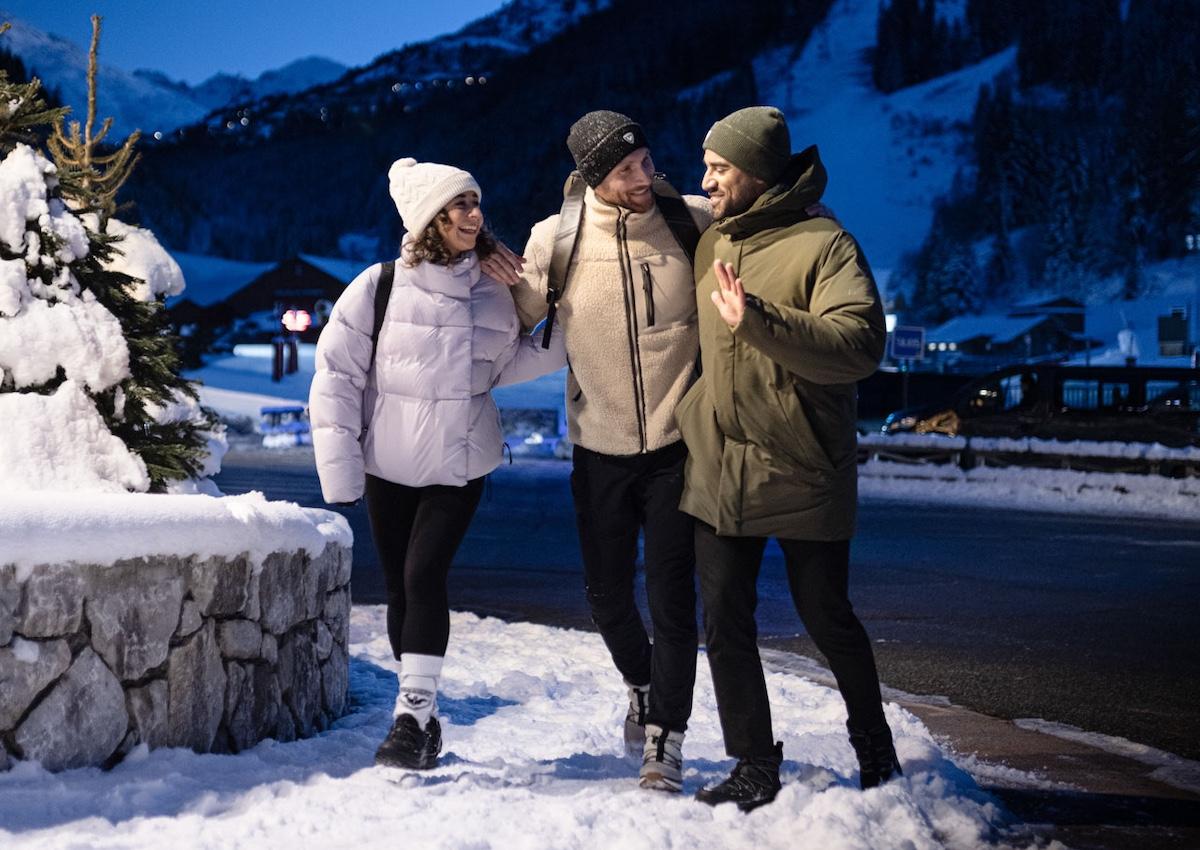If you’re getting ready for your next trip to the mountains and worried about forgetting something important, this checklist is made for you! Glisshop offers a comprehensive guide to all the essentials you’ll need for your ski holiday. From technical clothing to safety gear and handy accessories, you’ll find all our expert advice to make sure nothing is left to chance. Discover our detailed checklist now for a perfectly organised ski trip.
Ski trip packing list to download/print (PDF)
Here’s the complete list of must-haves for your winter holiday. Download it and tick off each item as you pack.
Skiing/Snowboarding Equipment List
- Skis or snowboard + bindings
- Ski boots or snowboard boots
- Ski poles
- Ski helmet
- Ski goggles + sunglasses
- Avalanche transceiver (beacon)
- Probe and shovel (avalanche safety trio)
- Back protector and knee pads
- Wrist guards
- Backpack with ski carry system
Technical Clothing
- Ski jacket (waterproof and breathable)
- Ski trousers or ski suit
- 3–4 sets of technical base layers (top + bottom)
- 2–3 fleeces or lightweight down jackets
- Ski gloves waterproof + liner gloves
- Technical beanie + neck warmer
- Multiple pairs of ski socks
- Scarf or neck tube
Footwear and Après-ski
- Winter boots
- Comfortable shoes or trainers
- Indoor slippers
Accessories and Toiletries
- Sunscreen (SPF 50+)
- Lip balm
- After-sun cream
- Deodorant
- Shower gel + shampoo
- Insulated water bottle or hydration bladder
- Energy bars
- Towels
Transport and Documents
- ID card
- Health Insurance Card
- Accommodation bookings
- Travel insurance and repatriation cover
- Private health insurance card
- Driving licence
- Snow chains for the car
- Ice scraper and de-icer
- Winter screen wash
- Warning triangle
- High-visibility vest
Loungewear and Nightwear
- Pyjamas
- Swimsuit (pool/spa/hot tubs)
- Cosy clothing for evenings
- Thick indoor socks
- Everyday underwear
First Aid Kit
- Plasters and dressings
- Painkillers (paracetamol, ibuprofen...)
- Arnica gel
- Personal medication
Entertainment and Relaxation
- Board games
- Book or e-reader
- Card games
- Earphones/headphones
- Chargers for electronic devices
- Power bank

What Should I Take on a Ski Trip?
Before closing your suitcase, make sure you’ve gathered the three main categories of essential gear: ski or snowboard equipment, technical clothing, and protective accessories.
At Glisshop, we guide you through every choice to ensure your mountain holiday is a success. The following sections detail each category to help you make the right decisions according to your ability and budget.
Glisshop Pro Tips for a Successful Trip
Before Departure
- Test all your ski equipment before leaving
- Check DIN settings and edge condition
- Pack spare clothing (falls happen)
- Bring plastic bags for wet clothes
- Book ski lessons in advance
- Download the resort app (weather, open runs)
During Your Stay
A great ski holiday is all about balance between activity and recovery. Alternate intense days on the slopes with rest days to maintain your energy. If the weather turns, take the opportunity to try other activities such as snowshoeing, a spa session, or a stroll around the resort.
Keep an eye on your gear: dry your boots and gloves every evening, charge your batteries, and check your avalanche transceiver before heading back out.
The Glisshop Approach
At Glisshop, we know that a great mountain holiday starts long before you leave. Our team helps you choose your equipment, maintain your skis, and select your technical apparel. Explore all our skiing guides to set off with peace of mind and make the most of every lap.
Your Equipment
Skis, Snowboards and Bindings
Glisshop ski + binding packages come with free professional mounting and personalised adjustment based on your profile. Our ski technicians handle everything: mounting, DIN setting, and compatibility check with your boots. You’ll have perfectly tuned gear suited to your style. Whether you’re after versatile all-mountain skis or a dedicated freeride board, our range covers every discipline and skill level.
For ready-to-ride equipment, discover our ski + binding packages. If you’re more into snowboarding, explore our selection of versatile snowboards.
Ski Boots and Snowboard Boots
Ski boots are the most personal part of your setup. Unlike skis, they must fit your foot shape perfectly to prevent pain and discomfort on the slopes.
A pair of ski or snowboard boots gradually moulds to your feet, ensuring lasting comfort season after season – browse our comfortable snowboard boots.
Helmet and Protective Gear
Your helmet is your most important piece of protection on the slopes, and its widespread use reflects growing safety awareness. At Glisshop, we always recommend models certified to EN 1077 standard with MIPS technology for optimal protection against rotational impacts – compare our ski and snowboard helmets.
Beyond the helmet, consider additional protection depending on your discipline:
- Back protectors: essential for freeride and park sessions
- Wrist guards: drastically reduce fractures among snowboarders
- Padded shorts: protect hips and coccyx during learning
- Knee pads: provide support and confidence on challenging terrain
Always ensure a perfect fit with a micro-adjustable system. A poorly fitted helmet loses much of its protective efficiency. For children, choose adjustable models that grow with them.
Among practical accessories, don’t forget a backpack with ski carry system. For capacity, choose between an ultra-compact 18–22 litre model or a mid-volume 26–28 litre version.
Clothing and Outfit: The 3-Layer Rule
Ski Jacket and Trousers
When carving down the slopes or exploring powder fields, your ski jacket and pants form your first line of defence against the elements. Waterproofness is key: look for ratings of at least 10,000 mm to stay dry in all conditions. Breathability is equally crucial to wick away perspiration during intense activity. Also check out our technical ski trousers.
Zipped ventilation systems allow you to adjust comfort according to effort level. Opt for models with integrated snow gaiters and reinforcements in high-wear areas (knees, cuffs) exposed to ski edges and poles.
For maximum comfort, ensure compatibility between jacket/trouser connection systems that effectively block snow ingress during falls. This extra protection makes a real difference on the slopes.
Base Layers and Fleeces
The foundation of your 3-layer system, base layers form your first barrier against the cold. Avoid cotton, which traps moisture; instead choose synthetic fibres or merino wool that wick sweat while retaining insulation.
The mid layer – fleece or lightweight down jacket – complements the system perfectly. Fleeces offer excellent warmth-to-breathability ratio, ideal for active days. For harsher conditions, a compact down jacket provides extra insulation without restricting movement – find a warm, lightweight fleece.
The 3-layer principle remains essential: technical base layer, fleece, and waterproof ski jacket.
To better understand how to choose materials and layering for different weather conditions – discover our guides on dressing for skiing.
Fit is crucial: your base layers should hug your body without excessive compression, allowing air circulation between layers. This airflow is key to effective thermoregulation, keeping you warm from first lift to last lap.
Gloves, Beanie and Warm Accessories
Your extremities are the most vulnerable to cold and deserve special attention. Hands quickly lose dexterity in freezing conditions, making pole handling difficult and potentially unsafe.
For ski gloves, choose according to your priorities. Mittens offer superior warmth as fingers share heat – ideal for very cold days. Five-finger gloves provide better dexterity for adjusting bindings, using your phone, or zipping up jackets – browse our Gore-Tex ski gloves.
Merino liner gloves are an excellent addition for those sensitive to cold.
A beanie remains essential even under a helmet to retain body heat. Choose thin, breathable models that fit easily beneath your helmet. A neck warmer provides extra protection against wind and snow.
At Glisshop, our range of warm accessories covers every need, from waterproof Gore-Tex gloves to technical beanies and hand warmers for the coldest days.

ID, Payment Methods...
Before leaving, check your identification documents: passport, Health Insurance Card. These are required for lift pass collection or in case of inspection.
For transport, ensure your snow chains fit your tyres and practise fitting them before departure. In mountain regions, their use is mandatory from 1 November to 31 March. Don’t forget your driving licence, accommodation bookings, and travel insurance. Also carry some cash for small expenses and an extra passport photo for certain season passes.
Packing Your Ski Bag for a 1-Week Trip
Item List by Category
Organising your ski luggage by category makes packing much easier and prevents last-minute oversights. Here’s our optimal breakdown for a week on the slopes, designed to help you check each item quickly and adjust quantities based on trip duration.
Tips to Maximise Space
Roll rather than fold your technical clothing: fleeces and base layers compress perfectly with this method.
Fill your winter boots with socks, liner gloves, and lip balm to use every bit of available space.
Wear your bulkiest items during travel: winter boots, ski jacket, and thick jumper. This saves considerable space while keeping you warm en route. Slip your camera inside your ski helmet for safe storage without wasting room. Also check our end-of-season ski equipment maintenance guide.
